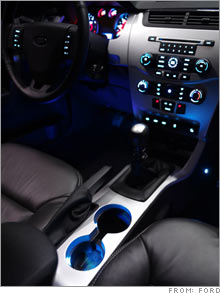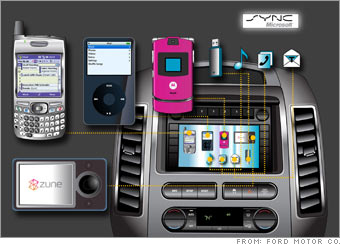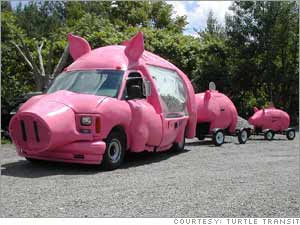BMW drops cover from 3-series convertible
 The accents were thick, the presentation was business-like, and the information was copious. It was, in other words, a typical BMW press conference. The accents were thick, the presentation was business-like, and the information was copious. It was, in other words, a typical BMW press conference.BMW traditionally uses Detroit as the platform from which to announce the previous year's sales figures, and the proceedings started with BMW board member Dr. Michael Ganal - filling in for the flu-ridden CEO, Norbert Reithofer - reporting a 3.5 percent jump in total retail sales to 1.37 million vehicles, 1.19 million of which wore BMW roundels. (For the record, Rolls-Royce put its gold-plated nose to the grindstone and chipped in with a record 804 Phantoms. Minis accounted for the rest.) Diesel vehicles have been big news at this year's show, and the BMW event continued the trend. While the Bavarians didn't have any oil burners on the show stand, they did announce that they would be offering diesel engines in the U.S. as soon as next year, and that the powerplants would comply with the emissions regulations of all fifty states. While all of that was certainly fascinating, the most important announcement was that of the 3-series convertible. The next-to-last version of the latest 3-series to be revealed - the wicked, V-8-powered M3 should drop this fall - the convertible now sports a retractable hard top for the first time. Made from steel, the lid will open or close in about twenty seconds. It goes on sale in March. Maserati Quattroporte Automatic
 Forgive us if we did not recognize the Italian gentleman who presided over the Maserati press conference this morning at Cobo Hall in Detroit: Fiat, Maserati's parent company, has shuffled so many executives in and out of the CEO chair at Maserati Spa, you'd think they were running a hair salon. Forgive us if we did not recognize the Italian gentleman who presided over the Maserati press conference this morning at Cobo Hall in Detroit: Fiat, Maserati's parent company, has shuffled so many executives in and out of the CEO chair at Maserati Spa, you'd think they were running a hair salon.Roberto Ronchi, the current man in the CEO's chair, has the requisite Italian suit and the requisite Italian accent, adding "ah" to the end of many of his words: "The new automatic is very important in the United States, because you make-ah very long journeys." The Quattroporte Automatic, which is now on sale for about $120,000, finally addresses complaints about the car's semi-manual paddle-shift transmission that have dogged the car since its introduction three years ago. That gearbox, called DuoSelect, will continue to be available, but most Americans will, we suspect, prefer the smooth new six-speed automatic to the DuoSelect's herky-jerky gearshifting, which really only worked when you drove the car very fast and aggressively. Lexus keeps journalists in the dark
 Lexus ushered journalists into a vast, dimly lit ballroom at Cobo, where I could barely see the floor in front of my chair, let alone the notebook in front of my face, to introduce the second iteration of the LF-A concept car that first appeared here two years ago. Lexus ushered journalists into a vast, dimly lit ballroom at Cobo, where I could barely see the floor in front of my chair, let alone the notebook in front of my face, to introduce the second iteration of the LF-A concept car that first appeared here two years ago.This car is a lot closer to production, and Lexus confirmed that it will be powered by a high-revving V-10 engine making at least 500 horsepower. If that sounds familiar, it' because just yesterday, Acura unveiled its Advanced Sports Car Concept, which also points the way toward a new, $100,000-plus sports car with a V-10 engine. The LF-A looks mean and very Japanese, with the long hood and short rear deck that you expect in a front-engine exotic. To be precise, Lexus calls this a front/mid-engine car, meaning the V-10 will be positioned behind the centerline of the front axle for ideal weight distribution, just like the V-12 in the Ferrari 599GTB. Two of the more interesting design fillips are the shark-fin air scoops molded into the top of the doors and the rear quarter-panel and the sculpted exterior mirrors. The nineteen-inch BBS wheels, covering big Brembo brakes, are hot, hot, hot. A V-8, high-performance version of the existing Lexus IS sedan also rolled out onto the stage. Badged the IS-F, it will go on sale a year from now, just in time to battle the next-generation BMW M3, which also gets a V-8. The "F" designation is a nod toward the internal code name used within Toyota back in the 1980s to refer to the original Lexus LS400: F1, for "flagship 1." Lexus has now appropriated this consonant as its own version of BMW's "M." Officials made it clear that a production version of the LF-A supercar will be the second Lexus vehicle to use the "F" designation. So, a big "F" you from Lexus here in Detroit. Wasn't there some other letter they could have used? Let there be Ambient Light
 There's a growing trend in vehicle design at this show, and it comes in the form of ambient interior lighting. Acura and Audi have been effectively employing this technique for a few years now on cars like the A4 and TSX, but other makes are quickly jumping in with various forms of soothing interior lighting. This goes beyond the bright dome lights that come when you open a door. I'm talking about the soft red (Audi A4), blue (Acura TSX), white (Bentley Continental GT) or amber (Saturn Aura) lights that reamain on whenever the headlights are on. These lights add an undeniable "premium-ness" to a cabin, and these days automakers are looking for every advantage they can get to make their product stand out in the eyes of consumers. At the Detroit Show this same type of soothing interior light has been specifically noted by company reps on everything from the updated Ford Focus to the redesigned Cadillac CTS. Think of this soothing light as the latest "it" trait, one that used to be the hallmark of concept cars only. Expect to see an increasing amount of creative cabin lighting in a showroom near you. In sync with Sync?
 At today's Detroit auto show, Ford was the recipient of much hype and star power when it introduced its Sync collaboration with Microsoft. At today's Detroit auto show, Ford was the recipient of much hype and star power when it introduced its Sync collaboration with Microsoft.Old-money Ford chairman Bill Ford trotted out new-money Microsoft Chairman Bill Gates on a satellite link from the Consumer Electronics Show in Las Vegas to introduce the system, which should provide seamless integration between vehicles and various electronic gadgets, such as Bluetooth phones and digital audio players. A mobile phone's telephony features, like address books, ringers, and speed dialing, are integrated through your vehicle's driver interaction system. The phone's voice recognition system can make them all hands free. Digital audio players, which will hook up through a USB port, will display their menu functions on the driver interaction screen and play through the audio system. (We hope they'll feature Bluetooth in the near future.) Even USB jump drives loaded with music will play on the car's audio system through the USB port. But while Ford was making its big splash with this mobile device gateway, automotive supplier Johnson Controls quietly introduced practically the same thing in a small conference room upstairs in Cobo Hall. Johnson says it is in talks with several automakers that are interested in this kind of connectivity and it might be found in production cars within a few years. So, don't think Ford has a better idea; it has a good idea that many others in the industry have had as well. No news yet as to whether the band *NSYNC will be endorsing either technology. Cyclical motion
 Product cycles -- the time a particular design stays on the market -- play a big role in the competitive automotive market. Product cycles -- the time a particular design stays on the market -- play a big role in the competitive automotive market.Some trends have emerged: Japanese marques redesign vehicles like clockwork every four or five years. On the other hand, some American cars stayed on the market far too long. Consider the last-generation of the Ford Taurus (1996-2006) or the Chevy Cavalier (1995-2004). But there are signs of hope. GM, in particular, is showing signs of squelching this trend. They've just unveiled an updated Cadillac CTS, which was first introduced in 2003. The Saturn Vue, introduced the same year, thankfully gets a big redesign for 2008. The current Chevrolet Malibu will have an even shorter lifespan (2004 to 2007). Product is everything in this business, and fresh product is even better. Honda Accord coupe concept
 Coming off its 11th consecutive year of record sales, and an aggressive program of hydrogen fuel cell development, Honda unveiled its latest take on the Honda Accord. Coming off its 11th consecutive year of record sales, and an aggressive program of hydrogen fuel cell development, Honda unveiled its latest take on the Honda Accord.Porsche's redesigned Cayenne
 Porsche chose Detroit for the worldwide debut of the new, updated Cayenne SUV. Porsche chose Detroit for the worldwide debut of the new, updated Cayenne SUV.First impressions; it looks better. The "visual lower center of gravity" look that Porsche stressed multiple times in the introduction makes for an improved, but by no means a beautiful, Cayenne. Even though fuel prices have dropped back down towards the $2.00 per gallon range, Porsche was proud to say that a new direct injection fuel system combined with aerodynamic advances should yield up to a fifteen-percent improvement in gas mileage. Don't be swayed too much. It will still be a thirsty beast, but at least performance improvements are also included. The top model, the Cayenne Turbo, puts out 500 hp and, according to the manufacturer, hits 60 mph in 4.9 seconds. All for the almost comical price of $93,700. Well, maybe not too comical. The better looking, but less powerful, supercharged Range Rover costs about the same. Prices for the base V6-powered Cayenne will start at $43,400 while the middle range Cayenne S starts at $57,900. As always, Porsche stresses that they do not discount their vehicles and this, combined with lower production numbers, historically yields excellent residual values. At the end of the press conference, the current CEO and president of Porsche, Dr Wendelin Wiedeking, stressed two points about the company. First, other than the introduction of the 4-door Panamera sedan in 2009, there will be no new Porsche models over the next five years. Also, Dr Wiedeking claims that Porsche will never build a modern version of a classic model like Ford did with the GT or Chevy with the Camaro. I guess building the same model since 1964, the 911, allows Porsche to keep the retro card firmly in hand. The most overused automotive marketing term
 "This vehicle is aimed at people with active lifestyles." "This vehicle is aimed at people with active lifestyles."We can't count how many times we've heard that phrase. Active, as opposed to inactive, I guess. Perhaps it's a tough sell to convince a board of directors that you want to sell a car to agoraphobics. Don't you think that speechwriters could come up with a new line? I mean, does everybody own a kayak, mountain bike or snowboard? We've said at Consumer Reports maybe a thousand times that almost nobody takes four-wheel drive vehicles off road. Off-roading for most SUVs is driving over patches of broken asphalt at the big box superstore. So who do the automakers think they're kidding? GM outpaces Toyota on hybrid tech
 So far, the two most intriguing and worthwhile debuts of 2007 Detroit Auto Show have been vehicles that we will never drive in their current guise. Both need further development and in one case, advanced battery technology. But the point is that they are here and exist within the halls and imaginations of two of the most aggressive OEMs in the U.S. market. So far, the two most intriguing and worthwhile debuts of 2007 Detroit Auto Show have been vehicles that we will never drive in their current guise. Both need further development and in one case, advanced battery technology. But the point is that they are here and exist within the halls and imaginations of two of the most aggressive OEMs in the U.S. market.One is from Toyota - not a big surprise. The other is from GM - surprised? The Toyota FT-HS, pictured here, is what I have been waiting for. (HS stands for "Hybrid Sports") As owner of a 2004 and 2006 Prius, I understand the hybrid promise and have put my own money on these horses. But "engaging" is not the word I would use when describing the day-to-day driving experience. The FT-HS is projected to hit 60 MPH in less than 5 seconds and deliver 35+ MPG.at a price very affordable to the common sports car enthusiast. A perfect hybrid evolution. But the Chevrolet Volt is special. (See a picture, plus Edmunds.com's take on it, here in the blog.) Hard to imagine (and even harder to type) but based on we have seen thus far, GM has an upper-hand in the Hybrid stakes. The Volt introduces us to an all-new powertrain concept named E-Flex, and it is an obvious 'slap-in-the-forehead' solution to our current and growing energy/security crisis. Since the gas engine is used 100% as a generator and never as a direct source of propulsion, the Volt of the future could deliver a theoretical range of 640 miles per small tank. And hit 60 MPH in a bit over 8 seconds. But most impressively, if the future driver uses the plug-in feature and recharges for all trips less than 40 miles, the engine would never even need to fire up. Mile upon mile without a visit to the gas station. And that is revolutionary. Ford's electric dream van
 Beneath the Ford Airstream's retro-futuristic monospace mosh-pit trappings lies Ford's interpretation of the drivetrain of the future. The Airstream uses fully electric drive, with front and rear motors boasting 174 peak horsepower. The electrons can either come out of a big battery, or a smaller one recharged by an engine or a fuel cell. Beneath the Ford Airstream's retro-futuristic monospace mosh-pit trappings lies Ford's interpretation of the drivetrain of the future. The Airstream uses fully electric drive, with front and rear motors boasting 174 peak horsepower. The electrons can either come out of a big battery, or a smaller one recharged by an engine or a fuel cell.The Airstream concept carries 14 pounds of hydrogen at 10,000 psi (10 pounds at 5000 psi is more likely for the nearer term) to power a conventional fuel cell. It also carries a plug-in 16-kW-hour lithium-ion battery pack good for 25 miles before the fuel cell stack comes on and runs at peak efficiency, maintaining the battery at between maybe 30-60-percent charge - that's lower than the current hybrids to allow space in the batteries to juice up on cheaper plug power at home.
CNNMoney.com Comment Policy: CNNMoney.com encourages you to add a comment to this discussion. You may not post any unlawful, threatening, libelous, defamatory, obscene, pornographic or other material that would violate the law. Please note that CNNMoney.com makes reasonable efforts to review all comments prior to posting and CNNMoney.com may edit comments for clarity or to keep out questionable or off-topic material. All comments should be relevant to the post and remain respectful of other authors and commenters. By submitting your comment, you hereby give CNNMoney.com the right, but not the obligation, to post, air, edit, exhibit, telecast, cablecast, webcast, re-use, publish, reproduce, use, license, print, distribute or otherwise use your comment(s) and accompanying personal identifying information via all forms of media now known or hereafter devised, worldwide, in perpetuity. CNNMoney.com Privacy Statement.
|
|
